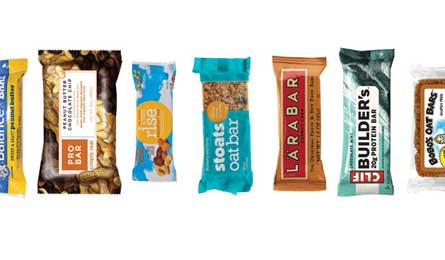Gear Guide 2012: Food - Trail Bars

'An energy bar for every occasion.'
>> ON-DEMAND ENERGY: HIGH-CARB BARS
Fast-burning carbs are an important on-the-trail energy source, especially for aerobic hikes lasting longer than 90 minutes. Most bars mix fast-absorbing simple carbohydrates (like processed sugars or fructose from fruits) with longer-lasting complex carbs (like those from whole grains and fiber-rich seeds). Carbs also restore depleted glycogen, which is necessary for muscle recovery.
Strategy
– Keep from bonking by scarfing 30 to 60 grams of carbo- hydrates every hour during hikes longer than 90 minutes; speed recovery by eating about .5 grams of carbs per pound of your body weight (along with protein) within 30 minutes of finishing your hike.
Try
– Bobo’s Oat Bars Maple Pecan; 64 grams of carbs (gluten-free), 380 calories; $38 for 12-bar box; bobosoatbars.com
– Lärabar Carrot Cake; 32 grams of carbs, 190 calories; $25 for 16-bar box; larabar.com
>> MUSCLE MAINTENANCE: PROTEIN-PACKED BARS
You need complete proteins—animal products like jerky or combinations of plant-based foods like rice and beans—to help repair muscle tissue. Amino acids (proteins’ building blocks) also help maintain electrolyte balance, boost immune system function, and synthesize hormones. They aren’t as easy to digest as carbohydrates, so protein-heavy snacks like nuts and cheese will make you feel fuller longer than carb-centric ones. Don’t load up all at once: Protein-dense meals during exercise may cause stomach upset and contribute to dehydration. Plus, protein won’t convert to usable energy as quickly as carbs. Instead, consume a small amount at every meal and snack, especially on high-intensity hiking days and at the beginning of extended trips, when your body will need to build backpacking muscles.
Strategy
– Repair muscle damage and combat fatigue from huge days (think Rainier ascent) by consuming a total of .5 to .75 grams of protein per pound of your body weight per day.
Try
– Clif Builder’s Bar Chocolate Mint; 20 grams of protein, 270 calories; $21 for 12-bar box; clifbar.com
– Balance Bar Bare Sweet & Salty Peanut Butter; 15 grams protein, 200 calories; $18 for 15-bar box; balance.com
>> SLOW-BURN POWER AND WARMTH: FAT-FUELED BARS
With a higher calorie-to-weight ratio than carbs or protein, fat is a key element in most backcountry menus. It’s valuable because of its high caloric density, because digesting fat boosts body temperature in cold weather, and because it fuels low-intensity activities like post-dinner strolls around camp. Avoid transfats (often added to processed foods to extend shelf life) and focus on heart-healthy mono- and polyunsaturated fats like those from nuts, seeds, and plant-based oils.
Strategy
Maintain energy for slow-paced, long-haul days (and to warm up on frigid nights) by munching .5 grams of fat per pound of your body weight per day.
Try
– ProBar Peanut Butter Chocolate Chip; 23 grams of fat, 393 calories; $39 for 12-bar box; theprobar.com – Stoats Blueberry and Honey Porridge Oat; 15 grams of fat, 310 calories; $4 for 5-bar box; stoats- porridgebars.co.uk